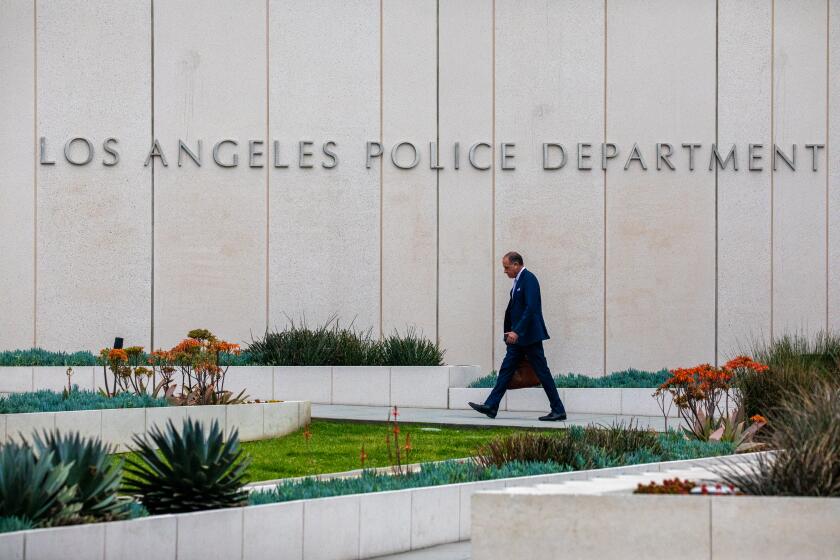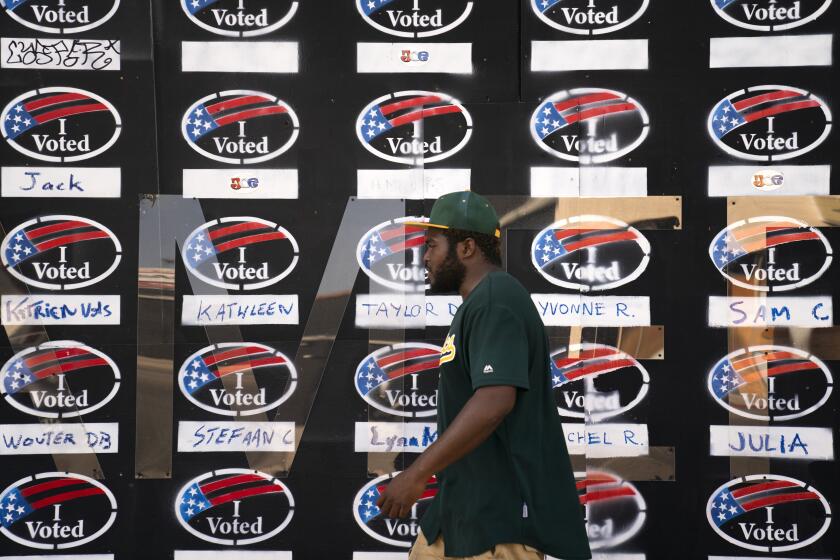L.A. occupies its own niche
A woman patrolled the tents of Occupy L.A., trying to drum up enthusiasm for an evening march. Each time she hollered into the fog, a group of followers echoed her, in an Occupy version of call-and-response known as the human microphone:
“If you could join us,” Shayne Eastin cried. “If you could join us,” they echoed. “That would be amazing!” “That would be amazing!”
But most of the campers didn’t want to be amazing. Nothing stirred from their tents but a bank of marijuana smoke.
“You’re used to organizing being more organized,” one woman told me. “This is more of a free-flowing thing.”
With Wall Street’s Zuccotti Park dismantled, and Frank Ogawa Plaza in Oakland cleared, Occupy L.A. may be the last major U.S. outpost of the 99% movement left standing. Who would have thought it? From the beginning, critics have derided the City Hall protest as the lamest in the worldwide Occupy movement.
The camp had no demands or agenda. Its muddled message wasn’t clear to the public, or even to some of those huddled beneath its grimy tarps.
At noon, Occupy L.A. held a yoga class, and at midnight, techno music throbbed across the south lawn for kids with glow sticks and hula hoops to dance to. Even Occupiers from other camps mocked L.A. as “the Big Love-In.” This, from an organization that popularized “spirit fingers” (more on them later).
But the mockery is misplaced. What may appear ridiculous about Occupy L.A. is what makes it important. Occupy L.A. is not a policy forum or a political party. It’s an experience — and an experiment in shaping a new political culture. And time and again, social experimentation in California has wrought more change than direct political action.
Raise your hand if you know a single word of the Port Huron statement, Tom Hayden’s manifesto for Students for a Democratic Society, the serious radical thinkers of their day. Why was the Weather Underground building bombs in that Greenwich Village town house again?
But everybody knows slow food, yoga and sustainable buildings. They trace their roots to the sometimes wacky communes, collectives and affinity groups of the California-centric counter-culture of the 1960s and ‘70s that the serious radical thinkers made fun of.
Even Steve Jobs was an admirer of a hippie amalgam of the Sears catalog and the Farmers Almanac called the Whole Earth Catalog. Jobs famously compared the catalog to the Internet search engine Google.
All the Occupy camps practice direct democracy. What makes Occupy L.A. stand out is that it is not dominated by experienced organizers or activists, although there are some. It’s that it seems to have sparked something truly spontaneous.
In recent days, the usual scruffy kids and homeless — who decamped early on from Skid Row — drew visits from a 40-year-old professor and parents and teachers who brought children to bear witness. Salvadoran community leaders dropped off food; clergy organized interfaith services.
Astonishingly, even after 11/2 months clotted together in tattered tents, everyone seems to be mostly getting along, even though, as one Occupier put it, “some of these people are not in their right minds.”
The basic occupation of Occupy L.A. is group discussion, hours and hours of it. Committees meet through the day, culminating each evening in the General Assembly, which sets grand policy. Decisions are made by consensus or not at all.
The meetings have a culture, which developed through earlier political movements: Stackers make sure speakers take turns. Spirit fingers, which are kind of like jazz hands, say you like what you hear. A hard block, signified by crossing your forearms across your chest, says you don’t. One hard block can kill a proposal.
The human microphone is a way to alert campers to a march or demonstration, without a permit to bring in electronic amplification equipment.
The night of the impromptu march, the General Assembly debated how to respond to the crackdown on Occupy Wall Street. One of the more marginal hangers-on began ranting, “This is no party. This is the real.” He was surrounded by other people, who soothed him until he quieted down.
A USC student from Sherman Oaks, who gave his name as Elijah Wood, waited patiently for his turn to speak. Wood said he had been waiting for Occupy L.A. “my entire life.” All 21 years of it.
He recalled an incident from high school, when Los Angeles Unified School District wouldn’t let him take a literature class he was interested in because he’d “passed out of it.”
“I had to Occupy my English class,” Wood said. He just wanted to read books and write essays about them.
Nearby, Max Funk, 32, from Rancho Mirage, manned a table labeled “Solutions.” Funk said he was sensitive to charges the protesters hadn’t come up with anything real, hence his table.
Funk said he left a job bagging groceries to write a software program to transfer the banking system to the U.S. Treasury.
“Our job is to bring forward youthful ideas the government is lacking,” he said.
Next to Funk was an open-air tetrahedral frame an Occupier had thrown up. A camper stopped to explain its purpose: “You walk in and think about something interesting and see what happens.”
Occupy L.A. is no Eden. In recent days, the tents have started to smell.
But scoff at your peril. California has proved it before: Silly can change the world. Occupy that.
More to Read
Sign up for Essential California
The most important California stories and recommendations in your inbox every morning.
You may occasionally receive promotional content from the Los Angeles Times.










